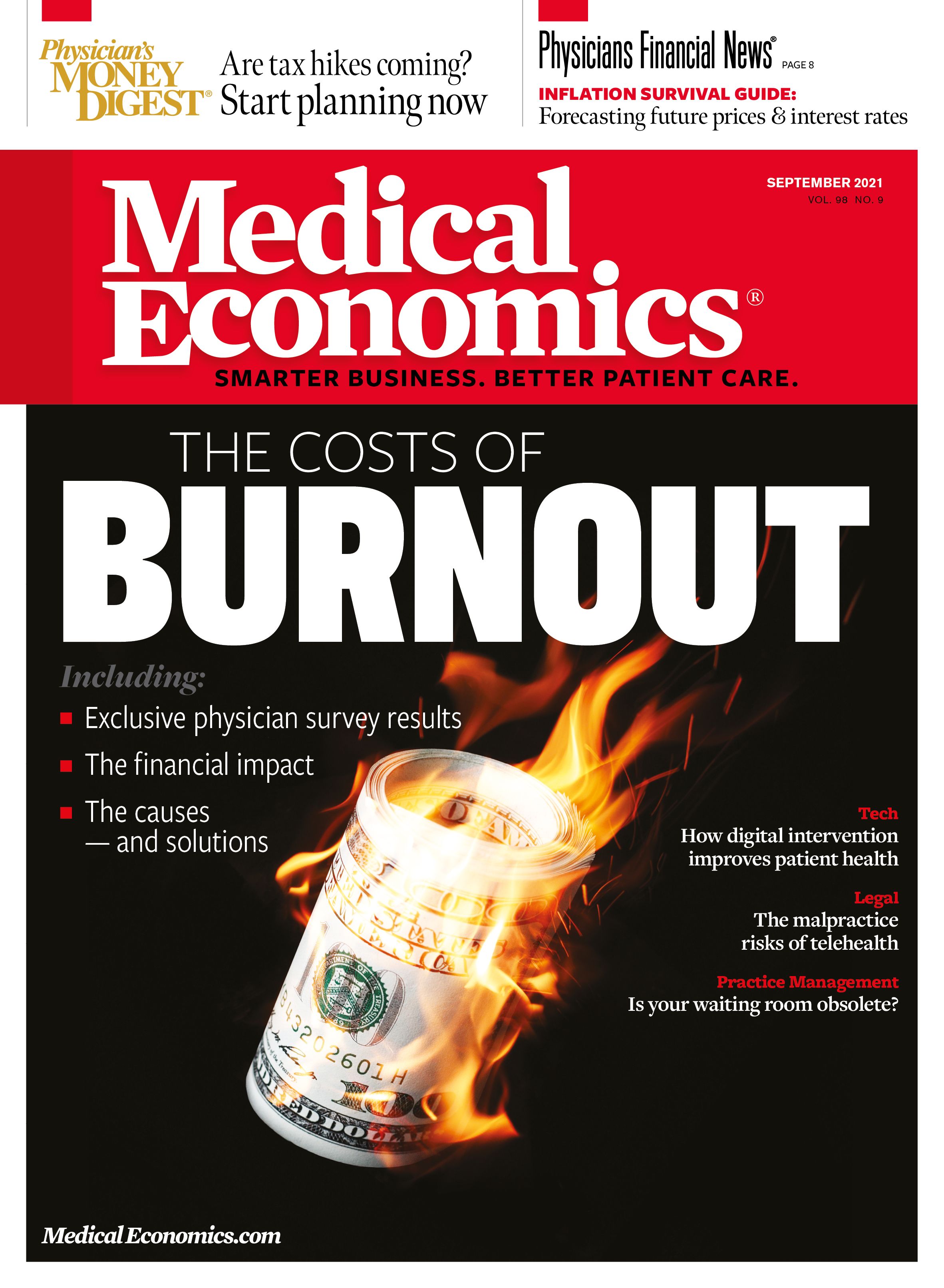Publication
Article
Medical Economics Journal
How practice culture affects physician burnout
Author(s):
A new study suggests that reducing burnout requires an organization-level response — creating medical practice cultures that value qualities such as teamwork, open communications and process improvement.
Efforts to combat physician burnout usually focus on individual doctors through programs aimed at building resiliency and dealing with stress resulting from systemic factors such as heavy workloads and loss of individual autonomy. But a new study suggests that reducing burnout requires an organization-level response — creating medical practice cultures that value qualities such as teamwork, open communications and process improvement.
To learn more about the study and its implications for reducing burnout, Medical Economics® spoke with lead author Samuel Edwards, M.D., who is an assistant professor of medicine at Oregon Health & Science University and a practicing internist with the Veterans Affairs (VA) Portland Health Care System. The interview has been edited for length and clarity.
Medical Economics® (ME): What led you and your colleagues to undertake this study?
Samuel Edwards, M.D.: This is part of a larger study, which was an evaluation of the EvidenceNow initiative. EvidenceNow was a large quality improvement initiative funded by the Agency for Healthcare Research and Quality, focused on improving cardiovascular preventative care in small- to medium-sized primary care practices.
Our group in Oregon was part of a large nationwide team funded to do an enterprise evaluation [of EvidenceNow] called ESCALATES, [which stands] for Evaluating System Change to Advance Learning and Take Evidence to Scale.
As part of that, specifically, we did surveys of practices and people in those practices at the start of the initiative in 2015, then several times throughout, and one thing we really wanted to understand was practice climate and burnout since it’s such a common and concerning issue in primary care.
ME : What did you find?
Edwards: One of the things we were interested in understanding was how much of burnout is a practice level phenomenon versus related to individuals. And we found definite evidence of a practice level effect in burnout. Specifically, we characterized practices by how much burnout they had in them.
What was interesting was we found that in 30% of our sample none of the practice members said they had any burnout. And given the dire descriptions of burnout in medicine today we thought that was an interesting finding, so we chose to focus on characterizing those zero-burnout practices versus a group of practices that were very high burnout to try and understand the differences.
We had this measure of practice culture which we called adaptive reserve. It consists of six domains: facilitative leadership, work environment, teamwork, sense-making, culture of learning and relationship infrastructure. All that stuff is superstrong. These practices used more quality improvement strategies, and they tended to be physician-owned solo practices and didn’t participate in large transformation initiatives like accountable care organizations or the Transforming Clinical Practice Initiative or a number of others. In general, we saw this signal that smaller practices with greater agency and a strong culture tended to have less burnout than other practices.
ME : Do you have any thoughts as to why practice culture is such an important factor in the presence and level of burnout?
Edwards: I think it’s intuitive to some extent. A place where you have strong leadership and good relationships among practice members have been shown to be associated with low burnout. One thing that stood out to us was that leadership is so important. Specifically, facilitative leadership, which is not traditional command and control, hierarchical leadership, but more fostering relationships, enhancing communication, attending to power imbalances, focusing on psychological safety and cultivating teamwork.
I think we can all identify with environments where we’ve felt that everyone’s on the same team, working towards a common mission that’s meaningful and important, where people like and care about each other, versus places where you don’t feel listened to, and you don’t feel like the work is important.
ME: I want to explore that term “psychological safety” a bit more. What do you mean by that?
Edwards: Psychological safety is basically the idea that you feel safe bringing things up. Like if there’s a problem, you’re willing to bring it up because you don’t feel like you’ll be criticized or punished for pointing it out. If you’re in an organization that’s trying to improve its performance and everyone’s too scared to say something’s wrong, you’re not going to get anywhere. You have to have that trust, that rich communication, that feeling you’re safe in bringing things up to really make progress. It has a superstrong relationship with burnout.
ME: Another interesting finding was that zero-burnout practices tended to be ones that didn’t participate in accountable care organizations. I’m wondering if you think that might discourage practices from joining accountable care organizations (ACOs), and if so, what affect that might have on the drive to move practices towards value-based care?
Edwards: That’s a great question. On the one hand it’s important to remember that all these practices were willing to participate in EvidenceNow, so they were already practices ready to engage with a large quality improvement effort. But the signal around ACOs was pretty strong. We’ve cut these data several different ways and this is a pretty strong relationship.
Since this is a cross-sectional analysis the “why” and “how” is difficult to say. But some ideas we had is that maybe it’s kind of an overload for practices, like if you’re involved in too many quality improvement initiatives pulling you in too many different directions that might contribute to burnout. We know that different health plans use different measures and ACOs have different measures and that might lead to burnout.
ACOs vary a lot, too. On the one hand when you put ACO funding together with the independently owned practices and the solo practices you might imagine that ACOs represent a loss of agency for the practices. So practices that have more independent control of what they’re working on and why might have less burnout compared [with] those who are responding to more external demands.
But ACOs are not all monolithic, hospital-driven quality measure machines. A lot of them engage practices in constructive ways. So I don’t think there’s a single lesson here, but I think there’s reason for concern that some of the policy-level levers for improvement could be related to more burnout and we should understand why.
ME: Have you gotten any pushback to your study from CMS or organizations representing ACOs?
Edwards: No. But I think we all appreciate that fee-for-service primary care medicine is suboptimal and moving towards a system where practices are paid for meaningful work is reasonable. But there’s some evidence that some of these approaches that may be a little more top-down have the secondary impact of increasing burnout. But again, this is a cross-sectional study so we’re just theorizing based on the associations we see.
ME : You mentioned that a lot of the zero-burnout practices were small and/or clinician-owned. That’s not the kind of environment most primary care doctors practice in today. Can any of the features of zero-burnout practices be replicated in large health care institutions?
Edwards: Well, on the one hand there are a surprising number of smaller practices still in existence. But I operate in a large-practice environment and many doctors do nowadays. But it’s certainly possible to maintain a strong practice culture within a large organization. Making larger organizations feel small by having smaller practice groups with more autonomy about how they run their day-to-day operation and have more control can really make a big difference.
I think about our practice in the VA, which is a big federal system, we really take time on our team to build relationships so that we trust each other and work together to get the work done. We all share that common mission about providing primary care to our patients is important and meaningful, and we care about it.
A point I mentioned in the paper is the concept of facilitative leadership. We think it’s important for people with formal leadership positions to act that way, but we can also build that culture as a team and have everyone participate in a work environment where there’s open communication and trust.
ME: I suppose if you’re a hospital system the sweet spot is maintaining the efficiencies of a large organization while still giving practices and individual physicians enough autonomy to operate on their own and feel they’re an important part of the larger organization?
Edwards: Yeah, and there are so many pressures for these organizations — the financial pressures and quality reporting pressures. Everyone’s getting pushed to do a lot with less. If you give people complete autonomy it probably wouldn’t work. But we’re certainly seeing in primary care things have kind of reached a head, where there’s a lot of turnover, it’s hard to retain and recruit people to environments where they don’t have any control and aren’t inspired by the work. And obviously retention and recruitment is super-expensive, so it’s in their interest to make people happier, want to stay longer and hopefully do a better job.
But we saw examples in our study of larger practices that were able to achieve zero burnout and strong adaptive reserve.
ME: Are you planning any sort of follow-up to this study?
Edwards: We have three waves of this survey, so one thing we hope to do is look at the longitudinal data to see if burnout declined over the time of the intervention and maybe look at some of the associations there. Hard to say whether the intervention did it or maybe just the changing context and challenges that continue in primary care. But that’s what we’d like to do.
ME: What are the key takeaways from this study?
Edwards: I think burnout is definitely a practice- or organization-level phenomenon and it affects all employees, and that practice-level culture is really important and potentially a place for intervention. So fostering leadership development could be really powerful.
The fact that smaller practices with clinician ownership who don’t participate in ACOs have less burnout really illustrates the importance of agency. So improving agency at the practice level also will help reduce burnout.
ME: You say in the study that too many of the remedies for burnout have been aimed at the individual rather than the practice level and aiming at the individual will only take you so far.
Edwards: Absolutely true. And if you look at the burnout literature, it’s been recognized forever that work environments contribute to burnout. But we continue to offer individual-level solutions, even though we know that the organization and the core of the work environment is more of the cause. So I think our study just adds to the literature that organization-wide approaches are essential.






